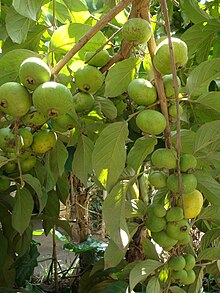Campomanesia lineatifolia
| Campomanesia lineatifolia | |
|---|---|

| |
| Scientific classification | |
| Kingdom: | Plantae |
| Clade: | Tracheophytes |
| Clade: | Angiosperms |
| Clade: | Eudicots |
| Clade: | Rosids |
| Order: | Myrtales |
| Family: | Myrtaceae |
| Genus: | Campomanesia |
| Species: | C. lineatifolia
|
| Binomial name | |
| Campomanesia lineatifolia | |
| Synonyms[2] | |
| |
Campomanesia lineatifolia is a species of plant in the family Myrtaceae.[2][3] Common names include guabiraba and perfume guava.[1]
Description
[edit]It is an evergreen tree with edible fruit that typically reaches 5 – 10 m in height. The fruits are berries (3 – 6 cm diameter, up to 140 g weight) and are gathered from trees growing either wild or under cultivation. The aromatic yellow fruit is eaten raw, made into juices, or pulped for use. A perfume can be extracted from the leaves.[4] An early illustration of the fruit was made in the mid-seventeenth century by Dorothea Eliza Smith.[4]
It has been used in traditional medicine to alleviate gastrointestinal disorders.[5]
Distribution and habitat
[edit]It is found in western South America - central and northern Brazil, Peru, Colombia, and Ecuador. It grows in regions with an average temperature of 22 – 30 °C with annual rainfall above 1,500 mm.[6]
References
[edit]- ^ a b Canteiro, C.; Lucas, E. (2019). "Campomanesia lineatifolia". IUCN Red List of Threatened Species. 2019: e.T129105021A129134212. doi:10.2305/IUCN.UK.2019-1.RLTS.T129105021A129134212.en. Retrieved January 19, 2025.
- ^ a b "Campomanesia lineatifolia Ruiz & Pav". Plants of the World Online. The Trustees of the Royal Botanic Gardens, Kew. n.d. Retrieved January 19, 2025.
- ^ "Campomanesia lineatifolia Ruiz & Pav". Catalogue of Life. Species 2000. n.d. Retrieved January 19, 2025.
- ^ a b Fern, Ken. "Campomanesia lineatifolia". Useful Tropical Plants. Retrieved 28 February 2020.
- ^ Madalosso, RC; Oliveira, GC; Martins, MT; al., et (2012). "Campomanesia lineatifolia Ruiz & Pav. as a gastroprotective agent". J. Ethnopharmacol. 139 (3): 772–779. doi:10.1016/j.jep.2011.12.014. PMID 22178179.
- ^ Aceru-Duarte, Luis Enrique (1979). Main useful plants of the Colombian Amazon. Forest Unit of the Radargrametric Proyeutu of the Amazon.

